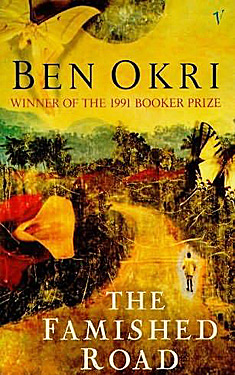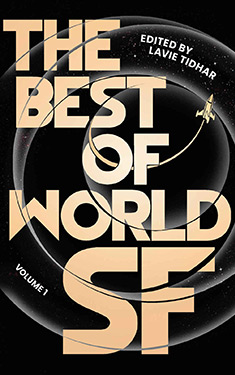
Added By: Administrator
Last Updated: Administrator
The Famished Road
| Author: | Ben Okri |
| Publisher: |
Jonathan Cape, 1991 |
| Series: | Famished Road: Book 1 |
|
1. The Famished Road |
|
| Book Type: | Novel |
| Genre: | Fantasy |
| Sub-Genre Tags: | Magical Realism |
| Awards: | |
| Lists: | |
| Links: |
|
| Avg Member Rating: |
|
|
|
|
Synopsis
In the decade since it won the Booker Prize, Ben Okri's Famished Road has become a classic. Like Salman Rushdie's Midnight's Children or Gabriel Garcia Marquez's One Hundred Years of Solitude, it combines brilliant narrative technique with a fresh vision to create an essential work of world literature.
The narrator, Azaro, is an abiku, a spirit child, who in the Yoruba tradition of Nigeria exists between life and death. The life he foresees for himself and the tale he tells is full of sadness and tragedy, but inexplicably he is born with a smile on his face. Nearly called back to the land of the dead, he is resurrected. But in their efforts to save their child, Azaro's loving parents are made destitute. The tension between the land of the living, with its violence and political struggles, and the temptations of the carefree kingdom of the spirits propels this latter-day Lazarus's story.
Excerpt
From the INTRODUCTION by Vanessa Guignery
'I felt on the edge of reality.' These are the words uttered by the narrator of The Famished Road as he recalls his venturing to a location that looked like 'a strange fairyland in the real world'. The sentence perfectly encapsulates the ambivalent and fragile position of a child whose wanderings take him and the readers of Okri's third novel to a multiplicity of places set in the real or the supernatural realm, or a mixture of both. A child of miracles, who knows no boundaries and observes what surrounds him with eyes wide open, Azaro is our very special guide into Okri's enchanting and terrifying worlds.
In 1991, the publication of The Famished Road marked the emergence of a unique literary voice, that of a writer who was born in 1959 in Minna, a railway town in central Nigeria, nineteen months before his country's independence, lived in London between the ages of one-and-a-half and seven, reluctantly travelled back to Nigeria with his parents and siblings in 1966, and eventually decided to settle in Great Britain at the age of nineteen. While the violence of the Nigeria--Biafra war of 1967-70 greatly affected the young boy, life in Lagos sparked his imagination, teaching him that 'there was no one world-view, but as many worlds as there are ways of seeing'. As a teenager, he closely observed his father practising law and taking up the cases of destitute people, which led him to develop a fascination for human beings and more particularly the voiceless and unheard victims of social inequalities. In 1978, he left Nigeria for London, which he considered the home of literature, and two years later published his first novel, Flowers and Shadows, in the Longman 'Drumbeat' series, a showcase for recent African writing. This was followed by The Landscapes Within in 1981 and two collections of short stories (Incidents at the Shrine in 1986 and Stars of the New Curfew in 1988), which prompted Chinua Achebe to name Okri as one of the new generation of African writers 'who hold a promise of becoming really major'. The promise was fulfilled with The Famished Road which won the Booker Prize, making Okri, at the time, the youngest recipient and first black African writer to receive the award. Three decades after winning the prestigious prize, Okri, for whom writing is an Arcadia, declared that 'the flame and the hunger and the dreams' were still there.
The Famished Road, Okri noted, was the outcome of a decade of experimentation with form, tone and tincture, in order to find the elixir that would enable him to create the imaginary world he had in mind. This implied, on the part of the author, a Blakean cleansing of the doors of perception to see, hear, smell, taste and touch the world differently. The novel invites readers to do likewise, to open their senses and minds, to look at and for what is not directly visible, 'not the things we s[ee], but the things in between, the myths in between, the tone in between', to quote Okri. When a character announces: 'We must look at the world with new eyes', he is echoing what Okri wrote in several poems, short stories and essays, and this new insight pertains to both the visible and the invisible. The reader is therefore encouraged to let go of previous assumptions, entrenched reading habits and Western binary conceptions which separate the living and the dead, the real and the supernatural. Instead, The Famished Road privileges circulation, the free flow of ideas, sensations, stories and worlds without boundaries. This implies that, in accordance with West African modes of being and perceiving, the spirits and the dead are part of the everyday environment of the living, making it possible for them all to eat at the same table and for a character of the compound to fight with the ghost of a deceased boxer. Okri recalls that his own childhood was 'populated with spirits, ghosts, deaths, war, hunger, magic, transformations, sorceries', and his awareness of an animist conception of the world led him to have 'a humble and magical relationship with reality'.
Just as Okri is 'a crossroads person, a child of intersection' between Africa and Europe, The Famished Road is a sea of stories deriving from West African mythology, European traditions and Eastern philosophies, which mix and intertwine with the author's own creations. In addition to the enigmatic stories his mother used to tell him and left him puzzling over for years afterwards, and the philosophical books, Greek and Roman myths, and Western classics his father liked so much, Okri let his mind resonate with many realities while writing the novel: 'the realities of Africa, but also the literary realities of writing in London, in full consciousness of a universal literary and artistic tradition, from Homer to Okigbo, from Monteverdi to Jazz, from cave paintings through Giotto and African art to Picasso and modernist and post-modernist trends'. Homer's Odyssey, which the main character reads to his father in the evening and which Okri refers to as 'an immortal tale of the cosmic difficulties of the return', has close affinities with The Famished Road. Okri noted about the epic poem: 'More than a book, it is a civilization, and yet it is an intimate story of a man, a family, an adventure', words which find a particular resonance with his own novel. It is certainly not surprising that Okri, who is an adept of the blurring of frontiers between nations and traditions, should have said: 'I feel Homer to be African.' The Famished Road also carries with it echoes of the Urhobo myths and realities the writer was introduced to by his father, and of the West African oral traditions and the wealth of folktales which inspired the mythical and supernatural works of Nigerian writers D. O. Fagunwa in Yoruba (Forest of a Thousand Daemons: A Hunter's Saga, 1938) and Amos Tutuola in English (The Palm-Wine Drinkard, 1952). Okri supplements these rich traditions with reminiscences of the original form of social realism that was developed by Chinua Achebe and of the encounter of the political and the mythical in the writings of Nobel Prize laureate Wole Soyinka. When Okri praised Soyinka for his reconciliation of 'the social with the mythic, the comic with the tragic', he could have been referring to his own work. As for the Nigerian poet Christopher Okigbo, of whom Okri is a great admirer, his combination of indigenous traditions with Western modernism and antiquity in his poetry may bring to mind Okri's own cultural and literary eclecticism. Although The Famished Road emerged from the reverberation of all these poems, tales, fables and myths in the writer's mind, the novel creates its own unique worlds, stories, voices and styles. Okri remarked that the writer has to get rid of 'the tendency to always anchor what is being done within a tradition' as such classifi ation destroys any attempt at originality, and the duty of the artist is specifically to cut new paths, 'travel the untravelled road', open new vistas.
The Famished Road was born from a dissatisfaction with the limitations of realism and marks a departure from Okri's earlier novels which focused on social and political issues in Lagos, and were written in the mode of social realism without any forays into the supernatural (in 1996, Okri would revise his second novel and 'transfigure' it into Dangerous Love, which he described as 'a kind of twin' to The Famished Road in its 'search for an artistic language with which to express the true nature of reality'). After completing these books, Okri explained that he 'got tired of the traditional artifices and realism of the novel' and that 'the naturalism of Tolstoy, Dickens and Balzac did not speak to the world [he] grew up in'. He started questioning what constitutes the essence of reality and developed a mode of writing that he described in various interviews as 'trans-realism', 'a deeper kind of realism' or 'a realism with many more dimensions'. In doing so, he was veering away not only from Western naturalism but also from the African literary trend of Chinua Achebe or Ngu˜ gi˜ wa Thiong'o (in Kenya), which had appropriated the form of the Western novel and used the mould of cultural nationalism to depict the indigenous African past. But neither did Okri strictly follow the model of Amos Tutuola's folkloric dream-narratives in which the supernatural prevails and is most of the time clearly differentiated from the real world. In The Famished Road, Okri opens a third way by weaving together the realistic and the esoteric, while never letting the mythopoeic and fantastic dimensions occupy the whole space (as would tend to be the case in his 1995 novel Astonishing the Gods, written 'in a mode of enchantment' while fasting). He is thus, as he said in an interview, 'inside and outside of realism': by incorporating mythical, animist and magical beliefs and manifestations within the real world, he is abiding by the African (especially Urhobo and Yoruba) belief that the spirits and the dead are an integral part of the world of the living.
In his foreword to Cervantes's The Dialogue of the Dogs (1613), Okri notes that the Spanish writer 'loves to mirror the world through odd angles and tangents', here by the means of two dogs talking about the follies, treacheries and mean-mindedness of humanity. The Famished Road likewise propounds an original perspective on the human condition, thanks to a child who is able to see 'the world of our reality and the world of spiritual reality simultaneously', one who is aware of anterior and future lives, and has access to other characters' dreams and thoughts. Okri explained that his wish and 'arduous brief ' when writing The Famished Road was to give 'voice to the living myth of the spirit child'. The main character, Azaro, is such a spirit child, a magical figure invented by Okri, which is a transformed incarnation of the abiku in Yoruba or the ogbanje in Igbo, a well-known figure in West African mythology who follows an endless cycle of birth, death and rebirth to the same mother, a helpless victim to this constant coming and going. The traditional figure of the abiku appears in many works of Nigerian literature, such as Amos Tutuola's My Life in the Bush of Ghosts (1954), John Pepper Clark-Bekederemo's poem 'Abiku' (1965), Wole Soyinka's poem similarly entitled 'Abiku' (1967), and Okri's poem 'Political Abiku' (1983), which starts with the following lines: 'He returned again / And again / Through her parturition / With executions on his fingers / With numberless deaths / As his rings of pearls'. In such texts, abikus are portrayed as mischievous, defiant and malevolent, indifferent to the suffering they cause their parents when returning to the world of the dead. When they are about to be born, these ambiguous beings make a pact to return to the spirit world at the first opportunity because, as noted in The Famished Road, they dislike 'the rigours of existence, the unfulfilled longings, the enshrined injustices of the world' and prefer to feast and play in their enchanting universe.
In Okri's novel, however, the spirit child is, in the author's words, 'another category altogether', a figure that is magical, hopeful, 'has the quality of liberty' and 'wills himself to live, against the power of death itself '. Indeed, the benevolent narrator-character decides to put an end to his mother's misery and to remain in the palpable world of the living even while retaining contact with his spirit companions who visit him and regularly attempt to lure him back to their world. The book therefore hovers between these different realities which meet and coexist, and Azaro, a wanderer who is born with 'an inextinguishable sense of exile', occupies an in-between position which enables him to make forays into the realm of the spirits while still living in the compound, thereby straddling the two worlds simultaneously. To the spirit child, this new environment is a quotidian journey of discovery, which will never let him take reality for granted, hence his constant bafflement and openmouthed wonder that lead him to marvel even at cobwebs and cockroaches. The mundane life Azaro chooses to adhere to is a challenging one: the novel presents in a poetic mode the harrowing condition of the ghetto dwellers who are exploited and persecuted by their landlords, employers and politicians, and vividly depicts the struggles of everyday life in the compound, at the marketplace or at the garage where people fight for survival in a general atmosphere of violence, tension and hunger. From his unique perspective, the spirit child is able to observe the evils of history, witness his father's shame, humiliation and defiance, and drink in 'the food of suffering' but he can also perceive the raw beauty of his mother's love, hear 'the walls talking, the chair complaining, the floor pacing, the insects gossiping', and hug 'the alarming mystery of reality'. Just as Caliban in The Tempest remarks that 'The isle is full of noises, / Sounds, and sweet airs, that give delight and hurt not', Azaro in The Famished Road is sensitive enough to hear the multifarious noises and voices coming from both the worldly and spiritual realms, from past, present and future. When a character asks the young boy how many ears he has, Azaro answers 'One' and adds: 'I hear things. Voices. Words. Trees. Flowers.' It is this dual and open consciousness which makes Azaro such a precious guide into the worlds of The Famished Road or what Okri calls the 'innumerable gradations of reality'.
The constant movement between different realities in the novel entails a fluidity of time and space, which recalls the enigmatic atmosphere of dreams. The Famished Road is set on the verge of a mysterious independence ('Independence is coming', one of the characters announces) and includes a few brief mentions of white men, colonial uniforms and the seizing of land, but no specific date or context for the action is given and the narrative eschews linearity, evolving instead in spirals, arabesques and cycles. The book espouses the free movements of myth and creativity, the ebb and flow of the imagination, rather than adhering to the teleological orientation of history. Although it opens with a sentence rich in biblical and mythical overtones ('In the beginning there was a river'), the novel challenges the notions of beginnings and endings, and borrows a sense of cyclicality and inconclusiveness from West African folklore tales. It comes as no surprise, therefore, that The Famished Road should not reach a definite closure on the last page but leave the door (and road) open for two later novels featuring the same characters, Songs of Enchantment (1993) and Infinite Riches (1998). To Okri, the idea of a book being finished sounds strange because books are restless and 'continue to clamour', 'continue to ask questions'. In the trilogy, the young protagonist Azaro does not develop in a linear way as in a traditional Bildungsroman but his adventures follow a pattern that is at once episodic and repetitive, balladic and cyclical, reminding one of the modes of narration favoured by the griot or African storyteller, as well as the structures of the picaresque and the epic. The Famished Road also shows that time can be perceived very differently by two individuals, one asserting that five hundred years have elapsed since they last met when another believes it has only been two weeks. 'Time is not what you think it is', one character states, thereby encouraging the reader to discard the conventional perception of time based on a rational division into countable units, and to embrace a more subjective, poetic and psychological approach to time and duration. Okri returns to the enigma of time in the introduction to The Magic Lamp (2017), a volume which pairs twenty-five stories by Okri and twenty-five paintings by Rosemary Clunie, when he writes: 'Time is a riddle which the writer and artist interpret in their dreams.'...
Copyright © 1991 by Ben Okri
Reviews
Images
No alternate cover images currently exist for this novel.



















 Full Details
Full Details






